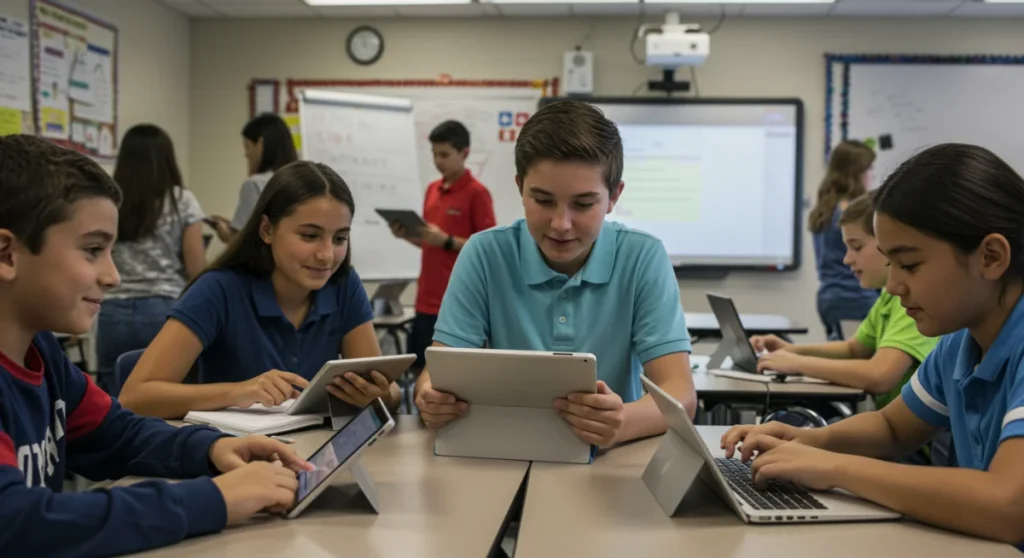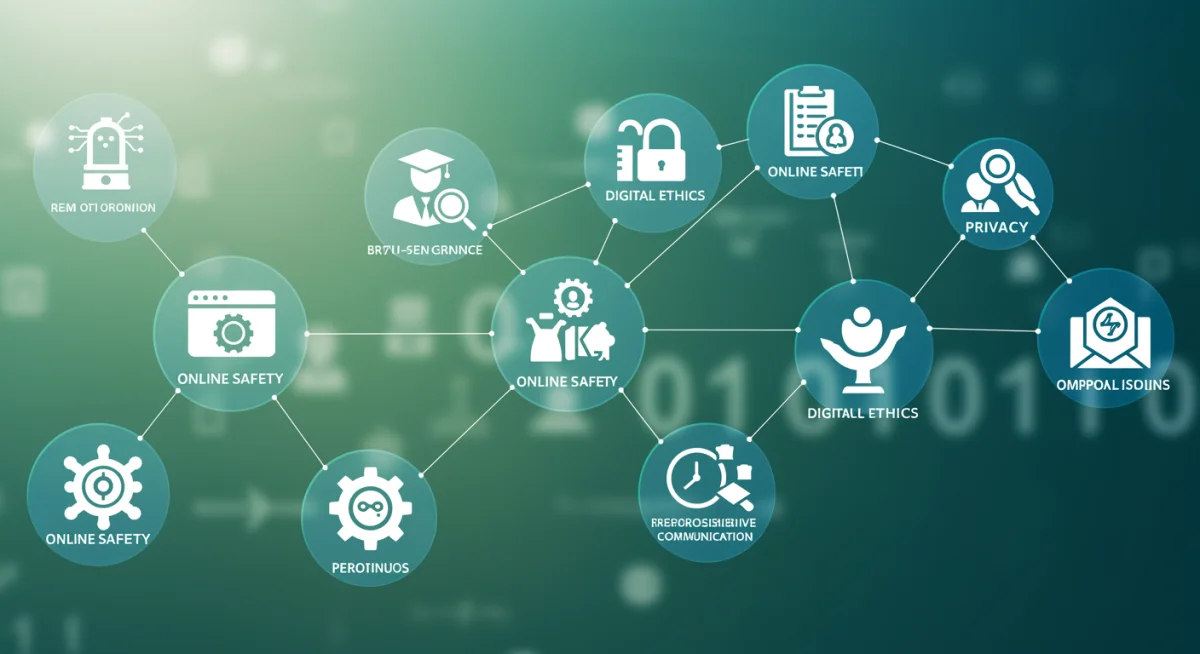Digital Literacy Standards: US Students’ 2025 Essentials

Anúncios
By 2025, US students must master key digital literacy standards, encompassing critical evaluation of online information, responsible digital citizenship, and safe, ethical technology use for academic and future career success.
Anúncios
As the digital landscape evolves at an unprecedented pace, understanding digital literacy standards becomes not just beneficial, but absolutely critical for the success of US students by 2025. This article delves into the core competencies and expectations shaping the future of education and employment in a hyper-connected world.
The evolving landscape of digital literacy
Anúncios
The concept of digital literacy has expanded far beyond mere computer proficiency. Today, it encompasses a wide array of skills necessary to thrive in an information-rich environment. For US students, this means navigating complex digital ecosystems with confidence and discernment.
The shift is driven by rapid technological advancements and the increasing integration of digital tools into every facet of life, from education to daily communication and future careers. Schools and educators are now tasked with preparing students not just for current technologies, but for those yet to be invented, emphasizing adaptability and critical thinking.
Defining digital literacy for the 21st century
Digital literacy can be broadly defined as the ability to find, evaluate, create, and communicate information, requiring both cognitive and technical skills. It’s about empowering students to be active, informed participants in the digital world, rather than passive consumers.
- Information literacy: Locating, evaluating, and using information effectively.
- Media literacy: Understanding how media messages are constructed and interpreted.
- ICT literacy: Proficiency in using digital tools and technologies.
- Digital citizenship: Responsible and ethical behavior in digital environments.
Ultimately, the evolving landscape demands a holistic approach to digital education, ensuring students possess the foundational knowledge and flexible skills needed to adapt to new digital challenges and opportunities.
Critical evaluation of online information
In an age of abundant, often unfiltered, information, the ability to critically evaluate online content is paramount. US students by 2025 must be equipped to distinguish credible sources from misinformation and disinformation, a skill vital for academic integrity and informed decision-making.
This goes beyond simply knowing how to use a search engine; it involves a deeper understanding of algorithms, bias, and the motivations behind online content creation. Educators are focusing on methods to teach students how to question, cross-reference, and analyze information from diverse digital platforms.
Strategies for discerning credible sources
Teaching students to scrutinize the origin, purpose, and context of online information is crucial. This involves practical exercises and discussions that challenge their assumptions about what they encounter online.
- Source analysis: Investigating the author, publication, and date of content.
- Bias identification: Recognizing potential biases in news, social media, and websites.
- Fact-checking techniques: Utilizing reputable fact-checking sites and tools.
- Lateral reading: Verifying information by consulting other sources simultaneously.
By fostering these critical evaluation skills, students will be better prepared to navigate the complexities of the digital information ecosystem, making them more resilient to manipulation and better equipped to form well-reasoned opinions.
Digital citizenship and online safety
Digital citizenship encompasses the norms of appropriate, responsible, and healthy behavior in the digital world. For US students, this means understanding their rights and responsibilities, promoting positive online interactions, and safeguarding their personal information. Online safety is an integral part of this, addressing issues like cyberbullying, privacy, and secure data practices.
Schools are increasingly integrating lessons on digital etiquette, empathy, and the long-term consequences of online actions. The goal is to cultivate a generation of digital natives who are not only technologically adept but also ethically conscious and socially responsible members of the online community.
Key components of responsible digital behavior
Developing strong digital citizenship requires a multi-faceted approach, emphasizing respect, responsibility, and resilience in digital spaces. These elements are fundamental for students to protect themselves and contribute positively.

Ensuring students grasp the importance of these components will empower them to make informed decisions and act as responsible digital citizens, mitigating risks and fostering a safer online environment for everyone.
Creative content creation and communication
Beyond consuming information, digital literacy also involves the ability to create and communicate effectively using digital tools. US students by 2025 are expected to be proficient in various forms of digital expression, from multimedia presentations to coding and digital storytelling.
This aspect of digital literacy encourages innovation and problem-solving, allowing students to articulate their ideas, collaborate on projects, and share their work with broader audiences. It emphasizes that technology is not just a tool for learning, but also a powerful medium for creation and self-expression.
Tools and techniques for digital expression
Familiarity with a range of digital tools and platforms is essential for creative content creation. Students should be encouraged to experiment and develop their own unique digital voice.
- Multimedia production: Creating videos, podcasts, and interactive presentations.
- Digital design: Using graphic design software for visual communication.
- Coding and programming: Understanding basic computational thinking and logic.
- Online collaboration: Utilizing cloud-based tools for group projects and shared documents.
Mastering these skills will not only enhance their academic performance but also provide a significant advantage in future careers, where digital creativity and communication are highly valued.
Understanding data privacy and security
In an era where personal data is constantly collected and analyzed, understanding data privacy and security is a non-negotiable aspect of digital literacy. US students must comprehend the implications of sharing information online, the importance of robust passwords, and how to identify and avoid cybersecurity threats.
This involves educating them about data footprints, terms of service agreements, and the potential for identity theft or online scams. The goal is to instill a proactive mindset towards protecting their digital identity and personal information.
Protecting personal information in the digital age
Teaching students practical strategies for safeguarding their digital lives is crucial. This includes understanding privacy settings and the long-term impact of their online actions.
- Password management: Creating strong, unique passwords and using multi-factor authentication.
- Privacy settings: Configuring social media and app settings to control data sharing.
- Recognizing phishing and scams: Identifying suspicious emails, links, and messages.
- Understanding data collection: Being aware of how websites and apps collect and use personal data.
By empowering students with knowledge of data privacy and security, we equip them to navigate the digital world safely and responsibly, minimizing their exposure to online risks.
The role of educators and policy in digital literacy
Achieving comprehensive digital literacy standards by 2025 requires a concerted effort from educators, policymakers, and communities. Teachers need ongoing professional development to stay current with digital trends and effective pedagogical approaches, while policies must support equitable access to technology and digital learning resources.
Furthermore, curricula need to be dynamic, adaptable, and integrated across all subjects, not treated as a standalone topic. This ensures that digital literacy is woven into the fabric of daily learning, reflecting its pervasive role in the modern world.
Supporting effective digital literacy implementation
Successful implementation hinges on collaboration and continuous adaptation. A multi-stakeholder approach ensures that digital literacy initiatives are comprehensive and impactful.
- Teacher training: Providing educators with the skills and resources to teach digital literacy effectively.
- Curriculum integration: Embedding digital literacy across all subject areas, not just technology classes.
- Resource allocation: Ensuring schools have adequate technology infrastructure and internet access.
- Community engagement: Involving parents and local organizations in promoting digital literacy.
Through these collaborative efforts, we can ensure that every US student has the opportunity to develop the essential digital literacy skills needed for success in 2025 and beyond.
| Key Standard | Brief Description |
|---|---|
| Critical Information Evaluation | Ability to discern credible online sources from misinformation. |
| Digital Citizenship | Responsible, ethical, and safe behavior in digital environments. |
| Content Creation | Proficiency in using digital tools for creative expression and communication. |
| Data Privacy & Security | Understanding and protecting personal information online. |
Frequently asked questions about digital literacy
Digital literacy standards are crucial because they equip students with the essential skills to navigate an increasingly digital world, ensuring they can succeed academically, professionally, and as responsible citizens. These skills are fundamental for future employment and informed participation in society.
Computer literacy primarily focuses on the technical ability to use computer hardware and software. Digital literacy, however, is a broader concept that includes critical thinking, ethical considerations, and the ability to find, evaluate, create, and communicate information effectively in digital environments.
Schools can integrate digital literacy by embedding it across all subjects, not just as a standalone technology class. This involves providing professional development for teachers, ensuring equitable access to technology, and fostering projects that require critical evaluation, creation, and collaboration using digital tools.
Parents play a vital role by modeling responsible online behavior, discussing online safety and privacy with their children, and monitoring their digital activities. Encouraging critical thinking about online content and setting healthy screen time boundaries are also crucial contributions.
Key challenges include ensuring equitable access to technology and internet, providing adequate teacher training, keeping curricula current with rapid technological changes, and addressing the digital divide. Overcoming these requires sustained investment and collaborative efforts from all stakeholders.
Conclusion
The journey towards robust digital literacy standards for US students by 2025 is a dynamic and essential undertaking. It demands a holistic approach that cultivates critical thinking, responsible digital citizenship, creative expression, and a deep understanding of online safety and privacy. As technology continues to reshape our world, empowering students with these foundational skills will not only prepare them for the jobs of tomorrow but also enable them to become informed, ethical, and proactive participants in the global digital society. The collective effort of educators, policymakers, parents, and communities will be paramount in ensuring every student is ready for the challenges and opportunities of the digital age.